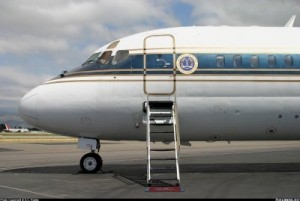 One of the greatest escapes since the Great Houdini was locked in handcuffs and leg-irons, nailed inside a crate, and lowered to the bottom of New York’s East River reached its conclusion two weeks ago, when a drug pilot who has escaped from custody in three different countries and eluded an international manhunt was arrested in a van with 70 kilos of cocaine in a parking lot at the Radisson Hotel in Caracas, Venezuela.
One of the greatest escapes since the Great Houdini was locked in handcuffs and leg-irons, nailed inside a crate, and lowered to the bottom of New York’s East River reached its conclusion two weeks ago, when a drug pilot who has escaped from custody in three different countries and eluded an international manhunt was arrested in a van with 70 kilos of cocaine in a parking lot at the Radisson Hotel in Caracas, Venezuela.
Carmelo Vasquez-Guerra, the pilot on two of the most infamous and controversial drug flights of the past decade, was taken into custody by Venezuelan police without incident, along with two other men, ending an incredible five-year long saga featuring repeated arrest… but little detention.
During that time Vasquez-Guerra was arrested, and then inexplicably released from custody, in not one…not two… but in three different countries, located on two separate continents. His astounding ability to slither out of serious trouble raises disturbing questions about who’s winning—and losing—the war on drugs.
Carmelo Vasquez-Guerra—in global drug trafficking—is The Great Houdini II.
Even so, when his time ran out, and his run from the law finally ended, he went out, not with a bang…
But a Twitter.
A Tweet from the Minister of Funny Walks
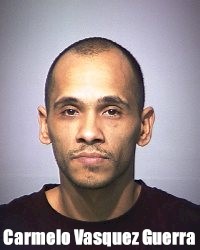 “Stopped in Caracas by the CICPC: Carmelo Guerra Vásquez,” twitted Tarek El Aissami, Venezuela’s Minister for the Interior and Justice. “Wanted by Interpol with a Red Notice for drug trafficking.”
“Stopped in Caracas by the CICPC: Carmelo Guerra Vásquez,” twitted Tarek El Aissami, Venezuela’s Minister for the Interior and Justice. “Wanted by Interpol with a Red Notice for drug trafficking.”
Fans of El Aissami on Twitter presumably know the significance of an Interpol “Red Notice.”
But even the uninitiated can make a good guess.
Carmelo Vásquez-Guerra, the most notorious drug pilot in the world, was in custody. It was an important event in a crucial struggle, because, when he talks, what he has to say will be of crucial importance in a larger arena.
Two combatants are locked in a death match: the American Drug Enforcement Administration, the DEA… and a man whose red beret has prompted more heartburn in the U.S. than anyone since Che Guevara.
Hugo Chavez is either Venezuela’s “President,” or Venezuela’s “strongman,” depending on your—or your native country’s—point of view. He was democratically elected, but is highly controversial, even feared, in his own country, and by large segments of his own people.
The ‘kingpin of kingpins’ in a global jihad?
Now, under the intense glare of a worldwide media spotlight, some big questions about Hugo Chavez are about to receive answers.
Is Chavez, through cronies like countrymen Vasquez-Guerra and Walid Makled—recently called the ‘kingpin of kingpins’by the U.S. Attorney in New York—a major global drug trafficker?
Is he collaborating in drug trafficking with elements of Al Qaeda, as the DEA charges, creating a drug pipeline from Venezuela through West Africa and the Sahara to Europe?
With the arrest of Carmelo Vasquez-Guerra (who, the government of Venezuela would like you to know, is the 60th drug trafficker being sought by Interpol caught in Venezuela since 2005), the possibility even exists that answers may be forthcoming.
If Venezuela extradites him to any of a number of countries where he is wanted for drug trafficking, Chavez will be throwing down the gauntlet—or at least the red beret—in front of the DEA.
What the world wants to know from the captured pilot are a few of his slippery secrets, which no one doubts he possesses, to illuminate the real politick of the global drug trade for those of us not initiated, or “read into,” the “clandestine mysteries.’
Because much of the global war on drugs is a propaganda war, his answers will have reverberations that may affect the balance of power in global drug trafficking for a generation.
Authorities in Mexico and the U.S., for example, weren’t sure of much when the DC9 from St Petersburg was busted in Campeche. But they were sure of one thing…the 5.5 tons of cocaine, they felt certain, didn’t belong to cronies of George W. Bush or Vicente Fox.
It belonged to the FARC.
A DTO All Star
What makes Carmelo Vasquez-Guerra such a standout clean-up hitter for a team of Drut Trafficking Organization All Stars?
Vasquez-Guerra first gained notoriety when he piloted the DC9 from St. Petersburg Florida. The plane was on its way back to the U.S. from Caracas when it was busted in April 2006 in the state of Campeche, Mexico
While Mexican soldiers were seizing his airplane, arresting the four other members of the crew, and setting up a perimeter ringing the out-of-the-way airport in Ciudad del Carmen, Vasquez Guerra somehow managed to… just slip away.
It was the first indication of just how slippery—and how well-connected—he would turn out to be, and it marked the beginning of a 5-year long quest to re-capture him, a quest which finally ended when authorities ‘slapped the cuffs’ on him two weeks ago.
The most suspicious indication, among many, which gave the drug flight away to Mexican soldiers, was that the flight which carried no passengers, but nonetheless had a cargo of 128 identical black leather suitcases. Stuffed inside those 128 suitcases, Mexican authorities discovered, was a stupefying 5.5. tons of cocaine.
For a short time at least, it was Christmas in Campeche.
Puzzling vagaries in official story
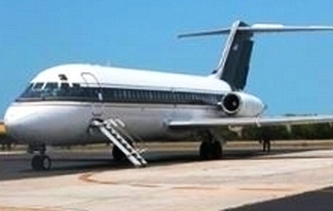 The 128 black leather suitcases stuffed with 5.5 tons of cocaine once again highlighted the “puzzling vagaries” in the U.S. Government’s official story about the war on drugs, where the “bad guys” somehow manage to slip more than 300 tons of cocaine a year into the country under the nose of a government that can read the make of a golf ball from outer space.
The 128 black leather suitcases stuffed with 5.5 tons of cocaine once again highlighted the “puzzling vagaries” in the U.S. Government’s official story about the war on drugs, where the “bad guys” somehow manage to slip more than 300 tons of cocaine a year into the country under the nose of a government that can read the make of a golf ball from outer space.
And of course there were the numerous unexplained ‘anomalies’ in Vasquez Guerra’s ‘escape’ that left unanswered questions, and a bad smell, given the “sensitivity” of the circumstances., which were special circumstances, indeed.
Take the DC9’s appearance, for example: An official-looking Seal beside the door, with an image of a U.S. Federal Eagle in the center, read: SKYWAY AIRCRAFT. PROTECTION OF AMERICA’S SKIES.”
It was so close to being identical to the seal of Homeland Security that it had led aviation observers, and even eagle-eyed planespotters, to repeatedly conclude, in the two years before it was caught, that it belonged to the U.S. Dept of Homeland Security.
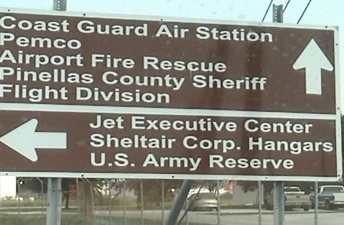 Moreover, it sat on the tarmac at Clearwater-St. Petersburg International Airport less than one hundred yards from the U.S. Coast Guard’s major Caribbean air station…with no questions asked.There was nary a peep from the Coast Guard (a DHW Agency).
Moreover, it sat on the tarmac at Clearwater-St. Petersburg International Airport less than one hundred yards from the U.S. Coast Guard’s major Caribbean air station…with no questions asked.There was nary a peep from the Coast Guard (a DHW Agency).
“We never could figure out how they could get away with that,” one SkyWay employee told us.
“They had the same seal on the fleet of Hummers, and local cops in Tampa pulled them over and made them take it off. But not the Coast Guard. Never.”
When questioned, officials at the Coast Guard Station have repeatedly refused to comment.
And then, of course, when the DC9 landed in Ciudad del Carmen, it was met by a Falcon business jet belonging to the Mexican Government, flown in by two pilots from the Mexican Federal Government’s Water Commission.
The term used by sociologists today to describe this particular set of circumstances is usually “State-Sponsored Organized Crime.”
“Say hello to my little friend.”
Later, the paper trail from the DC9 led Mexican investigators to the discovery that the plane had been purchased using drug money from a Mexican currency exchange which had extremely close ties to former Mexican President Vicente Fox.
Worse yet, money from the currency exchange had been knowingly laundered through the 4th largest bank in the U.S.
Wachovia Bank, we all learned a year ago, when it signed a consent decree with the U.S. government, had laundered an orders-of-magnitude and even-more stupefying amount of money than observers could have guessed in their wildest imaginings.
The figure given out was $385 billion. Some of it was used to buy the DC9.
All of it, the full $385 billion, came from sources which federal prosecutors said “cannot be verified.”
Money which “cannot be verified” is usually presumed to come from Tony Montana, whose business—the global drug trade—has weathered the Great Recession somewhat better than most.
Wachovia Bank was allowed to plead guilty to laundering a fraction of that amount, was fined $160 million, and then sold off to Wells Fargo Bank.
What Wachovia’s cut was for washing all that drug money is a figure yet to be revealed.
But reportedly Wachovia’s bankers were tittering behind their hands all the way to Salt Lake City, home of Wells Fargo.
The U.S. government is clearly still treating some elements of the drug trade—the well-heeled ones—as more equal than others.
Wachovia’s nasty habit of moving money around for Mexican drug smugglers provided the clean cash necessary for the purchase of a fleet of American planes, including the DC9, which cumulatively flew at least 22 tons of cocaine.
Mexico’s official drug policy: Catch & release?
While the date remains vague, Carmelo Vasquez Guerra was eventually taken into custody by Mexican authorities.
And even in Mexico, piloting 5.5 tons of cocaine would seem to call for more jail time than robbing a corner liquor store.
So reporters there assumed they’d heard the last of him for some time.
Imagine their surprise, as well as their chagrin, when Francisco Gomez of Mexico City’s El Universal newspaper discovered Vasquez-Guerra had been released from prison less than two years after being arrested.
And he was just one of six high profile drug traffickers imprisoned in Mexico who have been inexplicably released recently, Gomez reported, before asking: With certain favored drug traffickers, was the government of Mexico’s drug policy catch and release?
Questions about why and how the man got his freedom were received with official blank stares.
It wasn’t just that there was no official explanation.
There was no explanation at all. Reporter Gomez learned that Vasquez-Guerra was free by reading his name in an international headline which said he had been arrested in Africa flying a plane carrying 550 kilos of cocaine.
This was seen as proof, according to the laws of physics, even in Mexico, that he was no longer in prison.
Proof of Al Qaeda in the Magreb! Or maybe Fort Lauderdale
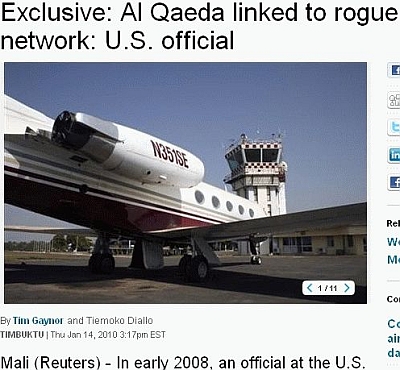 Carmelo Vasquez-Guerra had flown a drug flight on a Gulfstream II business jet, from Venezuela across the South Atlantic to Guinea-Bissau on the coast of West Africa, where it was busted… by mistake.
Carmelo Vasquez-Guerra had flown a drug flight on a Gulfstream II business jet, from Venezuela across the South Atlantic to Guinea-Bissau on the coast of West Africa, where it was busted… by mistake.
The bust was ‘pilot error.’ Vasquez-Guerra had landed at the wong airport, meaning, an airport where the Guinea-Bissau military weren’t ready to back up a truck to unload his plane when it landed.
Government Customs officials were allowed to inspect the plane, and it was busted.
Then… wonder of wonders! Under circumstances more murky than a cloudy night during a duststorm, he was once again released from jail.
And two weeks later, after being busted in the neighboring country of Mali, home of Timbuktu, he was released yet again.
Timbuktu is where the interdiction of the Gulfstream became a key event in the ongoing drama between the U.S. and Venezuela whose reverberations are still being felt, because that’s where an unidentified from the Dept. of Homeland Security announced the discovery of a drug pipeline pumping cocaine from Venezuela across the Atlantic to West Africa, where Al Qaeda in the Magreb took over, delivering it to Europe.
The example the official cited? Carmelo Vasquez-Guerra’s flight aboard a Gulfstream II, a plane whose home was the world-famous Fort Lauderdale Executive Airport, not previously known as a hotbed of Islamic jihadist activity. It was owned by a man named Luis Bustamante.
From the FARC to Chavez to Al Qaeda… It was a terrorist tri-fecta, and maybe the closest thing to a wet dream that grizzled old U.S. drug warriors like General Barry McCaffrey have had since 1957, when Jane Russell starred in “The Fuzzy Pink Nightgown.”
It’s too bad that none of it;s true. But that hasn’t seemed to matter.
The saga of the DC9, completely ignored by the mainstream media, was followed closely on this website—and only on this website—until the same thing happened again eighteen months later.
Then a Gulfstream II took off from the eerily-quiet Clearwater St. Petersburg International Airport, just as the DC9 had… and was caught in the Yucatan, just as the DC9 was… only this time it wasn’t carrying 5.5 tons of cocaine, but “only” four.
Tons, that is, of cocaine.
Also, the Gulfstream (N987SA) hadn’t needed to get painted to fool people into thinking it was a U.S. Government plane…
Because it had been one.
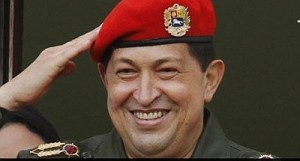
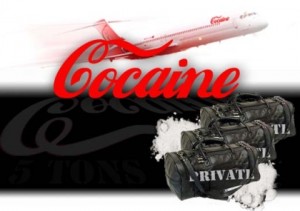
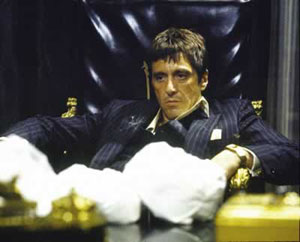
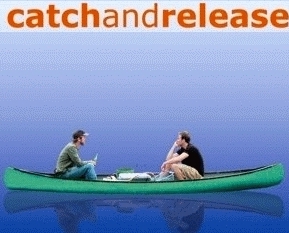
One response to “DC-9 COCAINE PILOT RE-RE-RE-ARRESTED”
I've been a regular visitor to your site for about 2 years. When I heard about this quake I immediately thought about you. Are you all right? Is your family safe?Bookish Babe